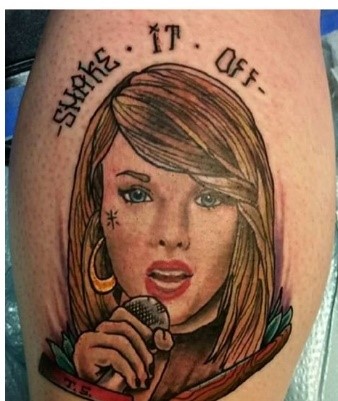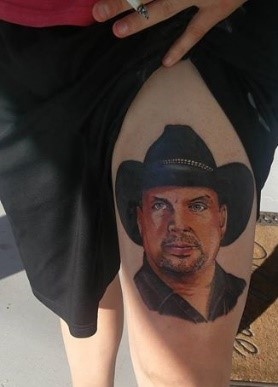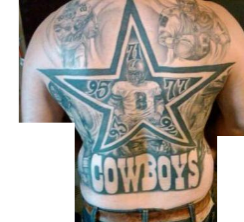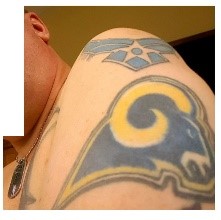This week’s blog is another guest entry from Chris Tanner, an artist, musician, inventor, and patent attorney. He holds several copyrights himself as a composer, is a former Patent Examiner, holds seven patents himself as an inventor, and has been practicing in patent, trademark, and copyright law for 21 years. More information can be found at either TannerPatent.com or SaveMoneyOnPatents.com.
SUMMARY
The readers of this blog and listeners of the weekly “Now Hear This Entertainment” podcast are likely familiar with protecting their musical rights, and are also likely familiar with tattoos. However, you may not realize that these are both protected by similar forms of Intellectual Property, specifically copyright and trademark.
DEFINITIONS
There is no easy, short, concise definition for a Trademark. However, typically, a Trademark is a name, word, phrase, logo, symbol, design, image, or a combination of these elements that is intended to or is being used in commerce. Trademarks exist to exclusively identify a source or origin of goods or services.
As with trademarks, there is no short, concise definition of copyright. Copyright law seeks to protect original literary, artistic and other creative works of authorship. Copyrights protect the expression of an idea, but not the underlying idea itself. The expression of the idea must occur in a fixed, tangible medium of expression, and human skin is certainly an example of this. Copyright protection can apply to writing, art, music, dramatic works and other creative exercises.
Another form of Intellectual Property is Right of Personal Publicity (RoPP), which is often used by celebrities to protect their image and likeness, not all of which can be protected by trademark or copyright. It is easy to confuse RoPP with Trademark, as these two have some overlap.
Trademarks exist to protect consumers, not sellers/creators, although sellers get an indirect benefit. Meanwhile, copyright exists to protect creators. This gives rise to a strange combination of protections which are not entirely compatible.
EXAMPLE TATTOO-IMAGES
If you remember nothing else from this blog post, remember this: a key factor in determining whether trademark problems exist is “likelihood of confusion,” as in, “would a purchaser of the goods/service in this industry be confused over the origin/source of this product.”

In the cases of the tattoos of Snow White or Mickey Mouse shown herein, the answer is likely “yes.” This is because these likenesses are instantly recognizable, and an average observer, even the reader of this article, might assume the tattoo arises from some type of implied license from Disney, thus Disney may be perceived as the “source” of the tattoo.


The same applies for the above tattoos of Taylor Swift and Garth Brooks. Further, these tattoos would also likely be considered a violation of their Rights of Personal Publicity (RoPP), because it’s extremely likely the tattoo artist did not have their permission to use these images.
One factor encouraging tattoo artists to take these risks is that the fees for applying such specialized images may be quite a bit higher than their usual fees. Further, criminal law enforcement entities such as police and FBI in some ways gain an advantage by the proliferation of such highly recognizable tattoos, as their existence can make criminal suspects easier to identify. Also, especially for the larger tattoos, it is difficult for criminal suspects to get rid of them or cover them up.
Here is a problem that many artists and musicians are not aware of. If a trademark owner does not maintain quality control and adequate supervision in relation to the manufacture and provision of products or services, this could be considered "naked licensing" or “unsupervised licensing.” Such behavior could eventually harm the trademark owner's rights in the trademark. The tattoos shown herein might also be described as “naked licensing,” but in a very diffused form. First, because some of the people shown herein, well, I would prefer to not think about them being naked.
But more importantly, with the proliferation of Internet images, and with the proliferation and commercialization of tattoos, it’s easy to “lose control” of one’s image and artistic creations. This is true even though an image-owner may be diligently protecting their creations. As such, a presumption of a “naked license” is now more rebuttable than it used to be. No one, and no entity, not even China, can entirely control the Internet.
Accordingly, the burden on the brand-owner to protect their brand must be reasonable. Policing potentially-infringing tattoos is difficult. The existence of Facebook and Instagram make the enforcement process much harder, because the re-posting of photographs of the tattoos can transform one infringing use into something being seen by literally millions of eyeballs.
Policing Facebook and YouTube and sending “takedown notices” may not be effective. While some of these tattoos are truly awful, and could be said to be “tarnishing” the brand (e.g. McDonald’s, Taylor Swift), finding the responsible actor could be difficult. It is important to properly identify the various actors. The true infringer is not so much the wearer of the tattoo as much as the tattoo artist, although both are culpable. But it’s unlikely the Facebook or Instagram images of any particular tattoo will show where that tattoo was created. That brings us to our next section, remedies for infringement.
ENFORCEMENT
A Federally Registered trademark (symbolized by ®) grants numerous rights upon the registered owner, including the right to exclusive use of the mark in relation to the products or services for which it is registered. The owner of a Federally Registered trademark ® can prevent unauthorized use of the mark in commerce. Tattoos are big business and certainly commercial. The test for whether infringement exists is, most often, whether a consumer of the goods or services will be confused as to the identity of the source or origin. This is known as “likelihood of confusion.”
Infringement of a copyright occurs when someone displays a copyrighted piece without permission of the author, although many times the infringement is de-minimus and thus tolerated. A copyright owner must prove the copied work has a negative effect on the work's value or potential market.
On the other hand, the skin-wearer is less likely to be considered infringing, since his display of the work is usually not for profit and in most cases would not meaningfully affect the work's value or market. While numerous of the tattoos shown herein are indeed hideous, unpleasant, and poorly applied, the link or connection between the tattoo wearer and the holder of the commercial rights is extremely distant. The target of any enforcement action, whether copyright or trademark, would likely be the tattoo-artist not the tattoo-wearer, although both may be culpable.
What makes all of this hella-confusing is that some commercial images can be separately protected by both copyright and trademark, while other images may only be protected by one or the other, or perhaps have no protection at all. Further, copyright is not just one clear statute, but an often-misunderstood set of statutes and cases from which it can be difficult to determine boundaries.
REMEDIES
The extent to which a trademark owner may prevent unauthorized use of their trademarks depends on various factors such as whether the trademark is Federally Registered (symbolized by ®), the similarity of the marks involved, and whether the owner's trademark is well known or famous. McDonalds and Mickey Mouse are certainly well-known and famous. Also, Disney and McDonalds have money and are diligent about supervising use of their images and marks.
The means and legal rationale for protecting copyrights is very different from protecting trademarks. This is an extremely confusing area of law, in which even experienced IP attorneys can have difficulties. Some concepts are not protectable by copyright, some are not protectable by trademark, some may be protectable only by one or the other, and some may be protected by both.
The Disney images shown herein are based on copyrighted and trademarked Disney images, and are likely doubly-infringing usages. An errant tattoo artist is thus subjecting himself to “double-trouble” legal liability, giving large entities like Disney, McDonalds, or Taylor Swift multiple ways to come after and bust him.
As stated, it is usually not cost-effective for Disney to pursue legal action against the person wearing these images, awful as they are. Instead, the most effective mechanism might be to prevent tattoo artists from making further copies of these specific tattoo-patterns, but even that is very difficult.
The NFL also has some very valuable commercial images that they try to protect. Below are some example NFL tattoos which are very likely to infringe the NFL’s copyrights and trademarks.


These tattoo-wearers may be surprised to find that the NFL is not amused by their intense (if not irrational) loyalty, but instead would like them to disclose the tattoo artist that performed the work. Further, when teams like the Rams change cities, the tattoo-wearer may lose their sense of loyalty and then faces the formidable task of getting the tattoo removed or re-rendered.
Large companies with significant brand reputation at stake go to great lengths to protect their copyrighted and trademarked images, spend a lot of money, and, unfortunately, can be harsh and rough when they bust somebody. One example of this is Disney, a company whose products are aimed at children, and as such those products are very vulnerable to misuse and misinterpretation. I chose Disney for examples because Disney has an extremely large budget and does not like their trademarks or copyrights violated or disparaged. I also chose Disney because of the numerous examples of disparaging and infringing tattoos that I was able to find. For some reason, people like tattoos that make fun of and disparage Disney and McDonalds characters.
A copyright owner must prove the copied work has a negative effect on the work's value or potential market. All the tattoos shown herein were chosen because they are likely to be examples of tattoos which have the requisite “negative effect,” and thus subject to a claim of copyright infringement. However, measuring and quantifying that negative effect could be difficult.
As stated, the best target would be the tattoo artist, who is much more likely to repeat the offense and thus cause further harm. But if the tattoo-wearer will not tell you, or is not available, how can one determine who is applying these tattoos? One way is to look at the “sample book” that many tattoo parlors keep, showing examples of their previous work. But even this practice has limited effectiveness. People with specific tattoo requests often bring their own desired images to the tattoo artist.
Many NFL fans are very devoted to their favorite teams. Many have NFL tattoos, although these are likely a violation of both copyright and trademark law. However, these fans would likely not inform NFL attorneys which specific tattoo artist drew their tattoos unless they were compelled to do so. Further, the tattoo artists already know to be careful to not to include their NFL specimens in their sample books, but may still agree to apply NFL tattoos because the profits on such tattoos may be quite large, perhaps larger than their usual fees. They also may not be aware of the trademark implications of their actions.
COMPARISON OF TRADEMARKS AND COPYRIGHT
Copyright law is among the most difficult of all forms of IP to summarize, especially the enforcement aspects. Rather than try to lay out a framework, it may be easier to explain copyright by contrasting copyright with trademarks. While trademark law seeks to clarify source of products/services, copyright law generally seeks to protect original literary, artistic and other creative works, and is often oblivious to any particular commercial impact.
Additionally, while both trademarks and copyrights have been around for hundreds of years, they originated separately, evolved differently, cover different activities, have different rules, and raise different public policy issues. Copyright law was designed to protect authorship and creative endeavors, and applies to the details of a work of authorship or art. Trademark law was not intended to promote business activity, but instead intended mainly to enable buyers to know what they are buying.
A trademark can be 'abandoned' or its registration can be cancelled or revoked if the mark is not continuously used. By comparison, copyrights do not go 'abandoned' merely because their owner stops using them in commerce. This is important from the standpoint of tattoos and tattoo artists, because copyright owners may not necessarily need to actively police their rights in order to make some kind of a stink. However, a failure to bring a timely trademark infringement suit or action against a known infringer may give the defendant a defense of implied consent or estoppel.
Accordingly, the trademark holders must be vigilant, “use it or lose it,” supervising their brand against even non-threatening usages, while copyright owners do not have the same duty. Thus, a tattoo artist may be more likely to hear from a trademark owner than a copyright owner, because of this affirmative duty. However, in either case, a big problem is how to supervise and prevent infringing mis-usages?
In summation, tattoos are an interesting form of intellectual property that is difficult to supervise, even though the commercial potential is enormous.
CONCLUSION
As tattoo art continues to grow and evolve and become a bigger part of our culture, the copyright and trademark laws and doctrine must evolve to keep pace with this trend. As stated, with the proliferation of Internet images, and tattoos, it’s easy to lose control of one’s image and artistic creations. At present, the copyright and trademark enforcement mechanisms are clumsy and misunderstood. Consequently, an aspiring musician, artist, or music manager should try to stay abreast of these trends and be fully aware of how to protect their own image and likeness.
Have you seen a tattoo that HAS to be a trademark violation? Is there a celebrity’s image that you’ve seen inked on one or more people? Has this blog changed the way you’ll look at tattoos, going forward? Talk about all of this in our Facebook group.
Read other guest blogs that we’ve published from Chris on tribute bands, copyright, Performance Rights Organizations, and Google/YouTube (vis-à-vis copyright).
